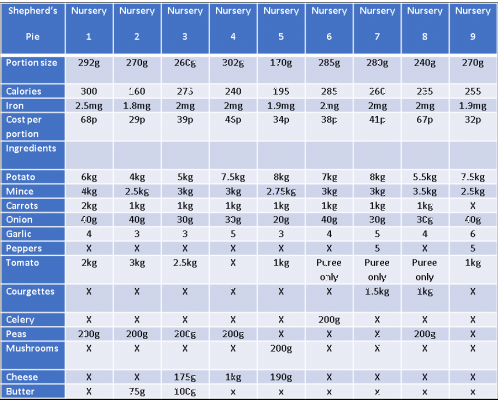It Is Possible To Cut Food Costs Without Sacrificing Quality, But You Must Know What You’re Serving

You cannot cost a meal without a recipe, says Nigel Denby

- by Nigel Denby
- Registered dietitian and founder of Grub4Life Visit website

For any business that provides food to its service users, efficiency is essential to survival. Yet all too often it’s overlooked in nurseries.
There is no single strategy to save money when it comes to food, but by implementing a few simple steps you can save small amounts here and there that will make a real difference to your food bills. As importantly, this strategy is critical to knowing the nutritional value of your food, and to being able to demonstrate that value.
Serving suggestions
Grub4Life carried out a very simple exercise that illustrates how nursery food budgets are often inefficiently managed. Nine chefs working across different sites within a nursery group were asked to write down the list of ingredients they would use to prepare a shepherd’s pie for 10 children.
The results, set out in the accompanying table, showed that while nurseries within the group used a centralised menu, this menu was interpreted at a local level, with chefs using their own recipes.
 The lack of a standardised menu was having a deleterious impact on nutrition and food budgets, and in effect had left the business with no measurable financial or nutritional food standards at all. Each shepherd’s pie recipe:
The lack of a standardised menu was having a deleterious impact on nutrition and food budgets, and in effect had left the business with no measurable financial or nutritional food standards at all. Each shepherd’s pie recipe:
| • | produced a different portion size, |
| • | provided different nutrient levels, |
| • | cost a different amount to produce. |
Standard recipes
Standard recipes are critical. Cooks tend to carry all their knowledge in their head, but that makes your business vulnerable: what happens if your cook is sick or leaves? All that knowledge goes with them.
From a budgeting point of view, you cannot cost a meal without a recipe. You need the recipe to tell you the quantity of ingredients needed to produce a specific number of portions. This is the information you need in order to negotiate discounts and special deals with local suppliers or wholesalers.
If you don’t know how much you use of an ingredient, you will always struggle to get a good deal. Waste can also be significantly improved using a portion-controlled recipe; it ensures you produce the right amount of food and acts as a very useful guide to serve the right-sized portion for each child.
From a nutritional point of view, portion-controlled recipes and standard menus are essential. Nutritional analysis relies on accuracy of ingredient weights and recipe yields; without these it’s impossible for you to demonstrate the nutritional value of your food.
Purchasing power
Whether you are an independent nursery or part of a national chain, you have the power to negotiate preferential rates with your suppliers, providing you have standard menus and portion-controlled recipes.
Independents
Local suppliers are often keen to advertise their links with local businesses, so you might want to consider displaying your local food supply network in the nursery. It’s a good marketing tool and USP for the nursery, and goes down well with parents. They will be much more able to negotiate a discount for you than a supermarket can – you have to ask, and be confident about the volumes of ingredients you need.
Trending
Markets
Would you pay £2 for a pineapple in a shop when you can get three pineapples for £1 on the fruit and veg market? If you’re lucky enough to have a local market, check it out. Talk to stall holders and establish a relationship with them. A single nursery is a very attractive regular customer to a trader; use your buying power to establish a discount.
Supermarkets
Supermarkets can be a convenient, time- and money-saving one-stop shop. Budget fruit and vegetables are just as nutritious as premium or organic fruit and veg; they’re just not as uniform in size and shape. Processed foods, like cereals, fruit juice, cold meats and bakery goods may vary nutritionally from the mainstream brands, so it’s important to compare labels before choosing the cheapest.
Grub4Life has worked with a number of nursery groups to help them plan and negotiate food supply from catering wholesalers. While this can be a big project, the savings that can be made with economies of scale cannot be ignored. The key tools you need are planned menus, recipes and clear ingredients requirements. You’ll also need an accurate estimate of your annual or monthly food spend. Some wholesalers are clued up to the needs of early years settings and understand under-fives’ nutritional needs; others are not so knowledgeable. Identify some key under-fives-friendly ingredients like tuna in spring water or low-salt stock cubes and see if a wholesaler stocks these.
Consistently creative
Agreeing a standard menu doesn’t mean being inflexible
| • | Use a rotational menu that operates over 3–4 weeks, with accompanying recipes that specify the number of portions they produce. |
| • | Your recipes can and should be from your cook’s own repertoire. Efficiency is not about stifling creativity. |
| • | Your menu and recipes can be flexible in order take advantage of special offers – eg you may want to include a weekly roast on the menu but leave the meat choice optional to take advantage of changing prices. |
| • | Similarly, fish pie can be made with a wide range of fish without adversely affecting its nutritional value. Fish prices vary enormously according to availability: coley, Vietnamese cobbler, haddock, plaice or pollock are equally as nutritious as cod, but will often be cheaper. |
Nigel Denby is a registered dietician and founder of Grub4Life. To find out more about the support he offers early years settings, email feedback@grub4life.com.
While online shopping does allow you to take advantage of ‘buy one, get one free’ and other special offers, for a nursery group it’s a long way from being the most efficient way to buy food:
| • | You have no control over use-by dates. |
| • | Replacements foods sent when a product is out of stock will not always be suitable replacements for children. |
Wholesalers
Grub4Life has worked with a number of nursery groups to help them plan and negotiate food supply from catering wholesalers. While this can be a big project, the savings that can be made with economies of scale cannot be ignored. The key tools you need are planned menus, recipes and clear ingredients requirements. You’ll also need an accurate estimate of your annual or monthly food spend. Some wholesalers are clued up to the needs of early years settings and understand under-fives’ nutritional needs; others are not so knowledgeable. Identify some key under-fives-friendly ingredients like tuna in spring water or low-salt stock cubes and see if a wholesaler stocks these.
Consistently creative
Agreeing a standard menu doesn’t mean being inflexible
| • | Use a rotational menu that operates over 3–4 weeks, with accompanying recipes that specify the number of portions they produce. |
| • | Your recipes can and should be from your cook’s own repertoire. Efficiency is not about stifling creativity. |
| • | Your menu and recipes can be flexible in order take advantage of special offers – eg you may want to include a weekly roast on the menu but leave the meat choice optional to take advantage of changing prices. |
| • | Similarly, fish pie can be made with a wide range of fish without adversely affecting its nutritional value. Fish prices vary enormously according to availability: coley, Vietnamese cobbler, haddock, plaice or pollock are equally as nutritious as cod, but will often be cheaper. |
Nigel Denby is a registered dietician and founder of Grub4Life. To find out more about the support he offers early years settings, email feedback@grub4life.com.










